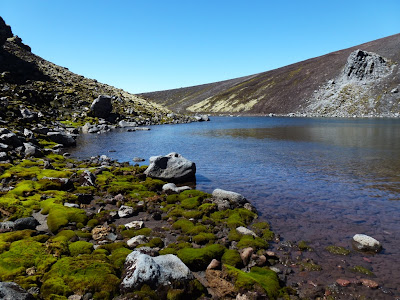My Christmas presents arrived today! Never have Christmas presents been so eagerly anticipated – and gratefully received! Thanks to Simon for Christmas pudding and Panettone and David & Nicky for a lovely warm jumper and socks - sent in October when it was really cold. Not to mention all the Christmas cards with nice messages inside. And a special consignment of food, kit and a copy of The Economist – the first newspaper I’ve seen in 5 months – kindly put together by my cousins Sandy and Ali in Cape Town. Thank you all very much! One present remains in transit somewhere – I’ll let you know if and when it arrives!
 |
| Carex insularis - one of only two Carex (sedge) species found on Tristan. |
Actually the presents arrived sometime last week, but we’ve been out of town on an eight day expedition and are just back. Such long camping trips are only possible with the help of islanders. We are only able to carry food for about four days - as well as our camping and recording equipment. We take cameras, hand lens, binoculars, GPS, handheld PDA (miniature computer), batteries, solar panel charger and recording forms. The weight of the rucksack makes difficult terrain even more difficult. So it was great to have a food drop to our remote 900 metre campsite on Soggy Plain.
We live on spaghetti and mince, meatballs or corned beef, and make enough each night to have for lunch the following day. Breakfasts are Weet-bix, sultanas, condensed milk mixed with boiled water. Treats include crisps, chocolate and a few apples. Tristan is a severe test of camping equipment. Two nights it got down to freezing and there was a dusting of snow on the Peak (remember it’s mid-summer). Another night there was storm force winds and it rained torrentially. And one day it was so wet, windy and foggy that we just stayed in our tents!
 |
| Soggy Plain (we camped by the pools) |
Despite this we covered a lot of ground. Difficult ground. And made some exciting discoveries – big but local populations of the rare ferns Dryopteris wallichiana, Hypolepis rugolusa and Asplenium insulare. And new grass and sedge species which don’t seem to have ever been previously described for Tristan – as far as we can tell. But it is always hard to know what the natural range of variation is for each species. Grasses and hook-sedges (Uncinia) continue to be difficult at altitude as many have yet to flower. Several pairs of closely similar species are being particularly difficult to separate, such as Grammitis magellanica and G. poeppigiana, and Elaphoglossum campylolepium and E. succisifolium (all ferns). Eagle-eyed Lourens spotted yet another population of the rare endemic rush Rostkovia tristanensis this time actually on Soggy Plain. (Prior to our project its only Tristan record was ‘above Soggy Plain at 1100 metres’ by the Norwegian Survey Expedition in 1938.)
 |
| Peak Berry, Empetrum rubrum |
We had a few mishaps. I slipped 20 foot into a deep water pool, skinning elbow and leg and soaking my camera. I was OK. More than I can say about the camera. In a separate incident we lost the GPS. Intensive searches were unsuccessful and we were almost benighted on the long circuitous return to camp. We keep the GPS on at all times to record our tracks, and download them to the mapping program Memory Map Navigator on our return to record our precise routes. So the main loss was the track data for 7 days and not the machine itself (though that was bad enough). We also rely on the GPS for the UTM 1km square reference and as a back up when the less sensitive PDA GPS fails to lock. Then there was a near-death incident involving the machete which I won’t recount as just thinking about it still makes my toes curl!
 |
| Gamochaeta thouarsii, better known as Cow Pudding Grass! |
Our return to the Settlement was equally exciting. It was hot and sunny with storm force winds and big waves. This made landing the rowing boat tender very tricky and our return on the Wave Dancer slow. Family and friends gather at the harbour to welcome their menfolk home. Once the boat is unloaded, winched out of the harbour for safety and the work is done, the men go round the houses celebrating their safe return with a drink or two. It quickly gets boisterous and women flee when the men invade. About six houses (and hours) later we end up in The Albatross. A good day after an eventful trip!
 |
| Infinity Pool with the sea 2,000 feet below. |






